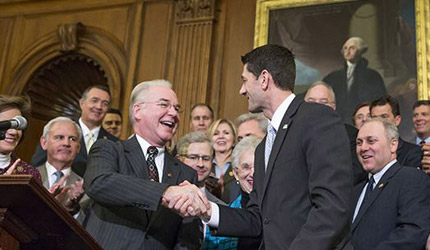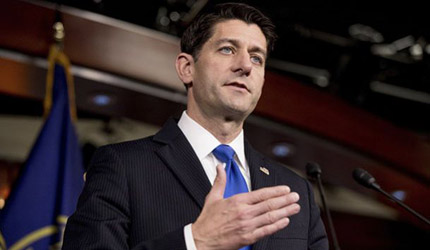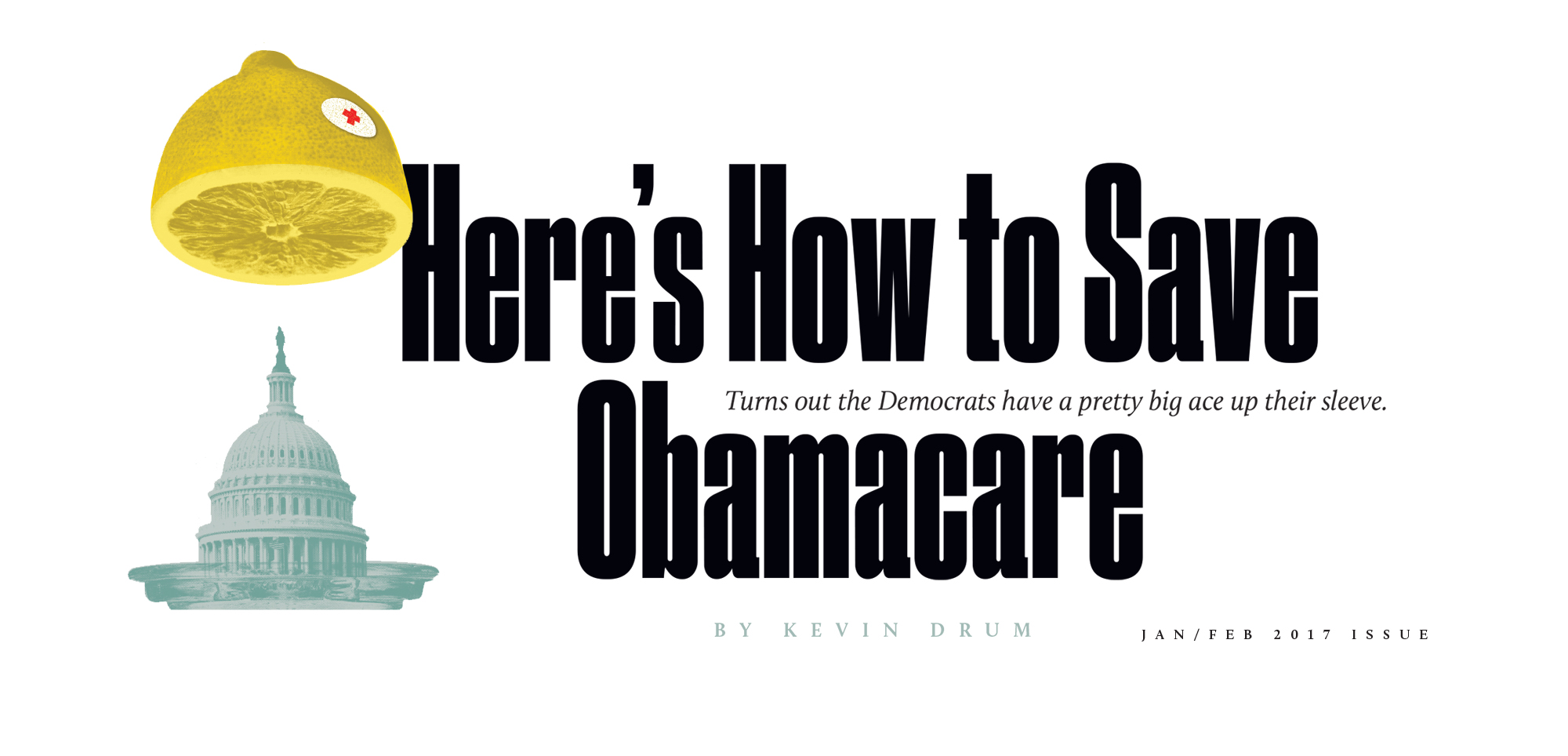Donald Trump campaigned on a promise to repeal President Barack Obama’s health care law. In fact, he vowed to ask Congress to deliver a full repeal “on day one.” Can he do that?
Well, no one can stop him from asking. But can Congress make it happen? Even a Republican Congress? The answer turns out to be sort of complicated. The legislative basics I’m about to spell out apply to everything Trump wants to do, so if you’re following along at home, here’s what to watch for over the next few months.
Let’s take the easiest option first. The only thing stopping Congress from a simple and total repeal of Obamacare is the fact that Democrats can filibuster any repeal bill in the Senate. Republicans need 60 votes to override a filibuster, and they don’t have them.
But what if they abolish the filibuster? Democrats got rid of it for lower-court judicial nominees and executive appointees in 2013, and Republicans could do the same for ordinary legislation if they wanted—because, ironically, you can’t filibuster a vote to eliminate the filibuster. If Republicans do this, the Obamacare question is simple: It’s dead. Congress merely has to pass repeal legislation with a simple majority and send it to President Trump’s desk for his signature.
However, this is an unlikely scenario, since plenty of Republicans are wary of abolishing the filibuster. After all, it’s a handy excuse to have around should mistrustful tea partiers start wondering why Congress hasn’t implemented their entire agenda. Plus, Republicans may need it themselves someday. So let’s move on. What can Republicans do with a simple majority?
This is where it gets complicated. Senate rules don’t permit a filibuster of budget bills. Anything that significantly affects spending or taxing is subject to a procedure called reconciliation, which allows passage by a simple majority. Thus, the health insurance subsidies and the new taxes in Obamacare could be eliminated via reconciliation because they affect the budget. However, nothing extraneous to taxing and spending is allowed in a reconciliation bill. Another rule—the Byrd rule—defines exactly what “extraneous” means.
But who interprets the Byrd rule? In practice, the Senate parliamentarian—an obscure official who guides lawmakers though the Senate’s byzantine rules and precedents—does this. So one possibility for Republicans is to argue that Obamacare should be considered a single entity that affects the federal budget, and that it can therefore be repealed as a single entity. If they put enough pressure on the parliamentarian, they might get a favorable ruling. In fact, back in 2001 Senate Republicans simply fired the parliamentarian when they didn’t get the rulings they wanted.
If Republicans take this route and get a favorable ruling, then once again Obamacare is dead. Republicans simply include reconciliation instructions in the budget bill, and when the budget is eventually passed, a full Obamacare repeal is included.
But let’s assume Republicans won’t do this, either. It would stretch the Byrd rule into a pretzel, and they’re probably as loath to do that as they are to eliminate the filibuster. This brings us to the most likely real-world scenario: the filibuster stays and the Byrd rule stays. In that case, what can Republicans repeal—and what can’t they? Here’s where it gets really complicated.

It turns out they can repeal a lot. In a 2015 dry run, both houses of Congress passed a reconciliation bill that included a repeal of most things people identify with Obamacare: the subsidies, the individual mandate, the expansion of Medicaid, all of Obamacare’s new taxes, and several smaller provisions. These were approved by the parliamentarian and would presumably pass muster again. (Obama vetoed the legislation a few days after it was passed.)
Although this sounds like a pretty thorough dismantling of Obamacare, it’s not. The original legislation was more than 1,000 pages long and contained hundreds of obscure but important regulations that Republicans can’t touch under reconciliation. Of these, one is by far the most important: preexisting conditions. Obamacare bans insurance companies from refusing to cover people with preexisting conditions, which means that if you apply for coverage, they’re required to sell it to you at the same price they’d sell it to anyone else. This particular provision of Obamacare clearly doesn’t affect the federal budget, so it can’t be repealed via reconciliation.
And that’s a big problem for the GOP. More than two-thirds of the country approves of this provision of the law, and Trump has said he wants to keep it. Republicans don’t have the votes to repeal it anyway. So what happens if you keep this provision but get rid of everything else?
Well, consider me. A little more than two years ago, I was diagnosed with cancer, which is currently being held at bay by about $100,000 worth of treatment per year. If I hadn’t been insured before that, I would have immediately bought insurance as soon as I found out. This means that some unlucky insurance company would have been forced to sell me health coverage even though it’d be guaranteed a huge loss on my policy.
Now what happens if lots of other people do the same thing? What if millions of healthy people skip health insurance entirely, buying it only if they get diagnosed with an expensive condition? This would have only a small impact on the employer market, since corporations insure everyone who works for them—which means insurance companies make plenty of money from healthy people to offset their losses from the small number of expensive patients.
But in the individual market, which accounts for about 7 percent of the total, healthy people would stay out while sick people would pile in. Insurance companies could lose tremendous amounts of money, and they’d have only two ways to respond. The first would be to stratospherically raise premiums for everybody. This is what happened in New York after state lawmakers passed a bill in 1992 requiring insurance companies to cover everyone. (Obamacare eventually helped bring down New York premiums.) The second response would be to simply stop selling individual policies. Millions of people would be left with nowhere to get insurance at all.
This is what Republicans have to deal with. It’s political suicide, which means they have to find some way to save the individual market even with the preexisting-conditions provision in place. Is it possible?
One place to look is “A Better Way,” a set of proposals from House Speaker Paul Ryan. The health care portion is 37 pages long and specifically says, “No American should ever be denied coverage or face a coverage exclusion on the basis of a pre-existing condition.” How does he manage that?

First, Ryan’s plan wouldn’t allow people to stop or start coverage whenever they wanted. Instead, insurance companies would be required to sell policies only to people who have maintained continuous coverage—and Ryan’s plan would provide refundable tax credits to help pay for it. In other words, unlike the Obamacare individual mandate, which encourages people to buy insurance by assessing a tax penalty on anyone who remains uncovered, Ryan’s plan encourages people to buy insurance by threatening them with the inability to get coverage if they ever get sick.
But what about people who don’t maintain continuous coverage despite the incentives? After all, Ryan’s plan specifically says it covers everyone. The answer is high-risk pools run by the states. Each state would run an insurance program specifically for people who can’t get insurance anywhere else. However, this pool would mainly consist of the very sick, which means insurance premiums would have to be very high. To help out with this cost, Ryan’s plan includes $25 billion in federal subsidies—where the money would come from isn’t completely clear—to keep the pools solvent even though premiums would be capped at a moderate level. Unlike the Obamacare subsidies, which are usually paid directly to the insurance companies, Ryan’s subsidies would be paid to the states, which would then turn them over to the insurance companies.
Finally, for the very poorest people, Ryan’s plan relies on Medicaid, which it suggests it could make more efficient via state-level flexibility and better incentives.
If you haven’t yet noticed what this all means, let me spell it out. The key parts of Obamacare and Ryan’s plan are the same. They both (a) rely on private insurance, (b) require insurance companies to cover people with preexisting conditions, (c) encourage people to buy insurance continuously by penalizing them if they don’t, (d) provide billions of dollars in federal subsidies to make insurance affordable for low-income households, and (e) rely on Medicaid for the very poorest.
In other words, Ryancare is basically Obamacare by another name. This is no coincidence. Health insurance, like any other kind of insurance, fundamentally relies on access to a large, random pool of people. In any given year, the few sick ones are paid for by the large number of healthy ones. But once you tinker with that by allowing healthy people to opt out, the whole system collapses. One way or another, you can save it only by forcing healthy people back into the pool and then providing subsidies to the ones who can’t afford coverage no matter what the law requires of them.

Ryan’s plan does that, but would it pass muster in court? After all, Obamacare’s preexisting-conditions provision would still be in place, because Republicans can’t repeal it. As long as that’s the case, someone with an expensive condition would be certain to sue, arguing that they still have the right to buy a plan from any insurer of their choosing regardless of whether they’ve maintained continuous coverage—and to buy it at the same price as anyone else. That’s a strong argument, which means this part of Ryan’s plan is likely to be struck down in court. Unless Republicans figure out a way to repeal the preexisting-conditions provision—perhaps by threatening havoc unless Democrats go along—there’s a good chance Ryan’s plan would fall apart. This would leave millions of people with serious health problems and no coverage, and Republicans taking the blame for it.
Finally, there’s one last scenario to consider. Let’s suppose a friendly court allows Ryan’s plan to replace Obamacare. Does this mean health coverage will be as good under Ryancare (or Trumpcare) as it is under Obamacare? Not at all. The basics are necessarily similar, but the Republican plan will be difficult to implement and is far less generous. Ryan’s plan, for example, budgets $25 billion for high-risk pools, while Obamacare budgets more than twice as much for its subsidies—and experience has shown that even this is barely adequate. Likewise, Ryan’s plan eliminates Obamacare’s Medicaid expansion, and it would be unlikely to make up for that with its various hand-waving proposals for wiping out fraud and improving efficiency. Almost certainly, millions of people would lose coverage entirely, and millions more would have to pay more for health insurance. Losing Obamacare in this way would cause tremendous hardship for a huge number of people.
Beyond this, there are a number of things President Trump could do to undermine Obamacare without waiting for Congress to act. He could remove resources from the enrollment program, making it harder for people to sign up. He could effectively end the individual mandate by redefining the hardship exemption to include anyone who simply says they can’t afford insurance. He could be much more flexible about allowing states to opt out of Obamacare via innovation waivers—and he could do the same for Medicaid waivers. Timothy Jost, a health care law expert, points out that Trump could also encourage insurance companies to drop out of the program, effectively killing it off. The Trump team’s words are important, he says, and what insurers do going forward “depends on signals they send over the next couple of months.”
So that’s the story. If Republicans choose to use extraordinary means—either axing the filibuster or bullying the Senate parliamentarian—they can fully repeal Obamacare and replace it with anything they want. Alternatively, they can leave the preexisting-conditions provision in place—along with all the other regulations they can’t touch—and create chaos by repealing everything else. But if they’re not willing to do that—and they probably aren’t, if only for reasons of political survival—Obamacare’s preexisting-conditions provision provides Democrats with some leverage. Republicans need Democratic votes to repeal the provision and pass a workable law, which means that if Democrats hold out they can certainly get a far better deal than Ryan’s plan. They might even be able to stop the Obamacare repeal in its tracks. It all depends on how well they play their hand.

















